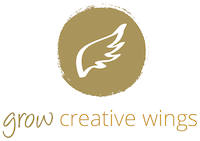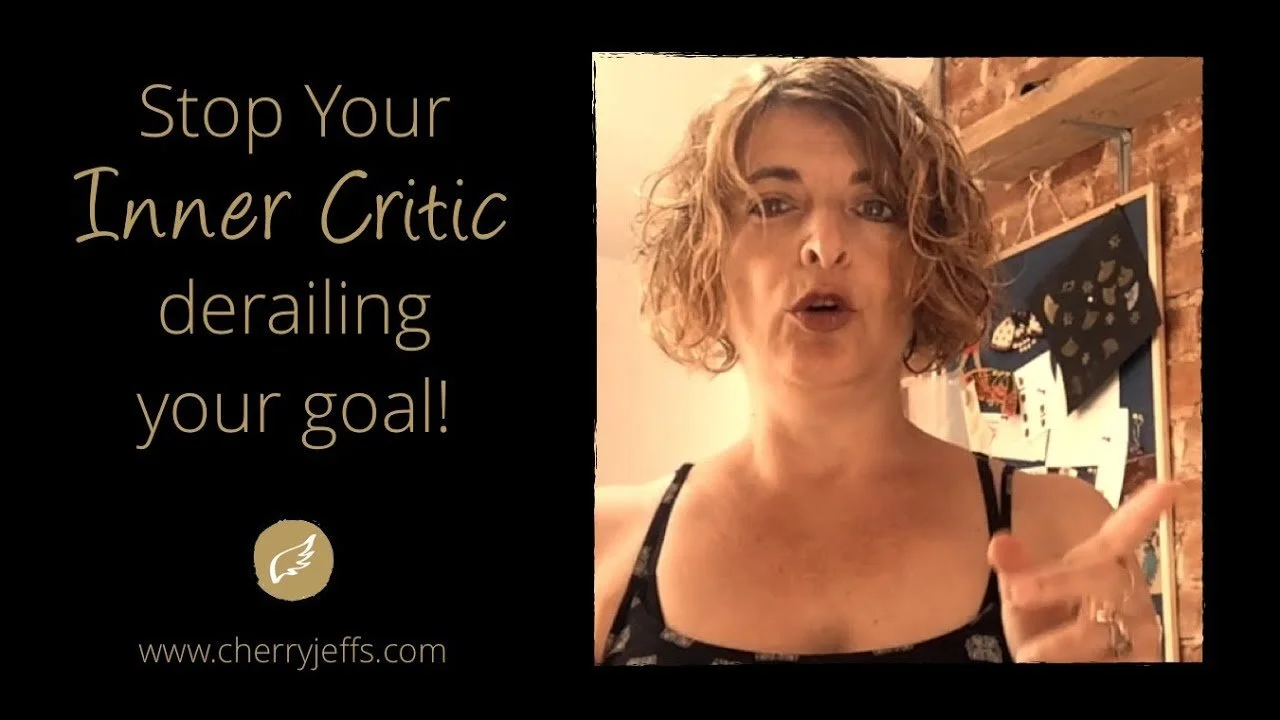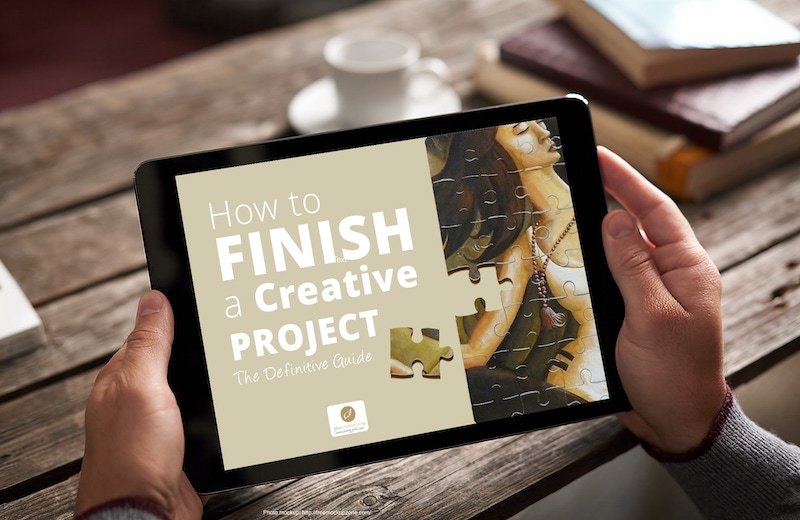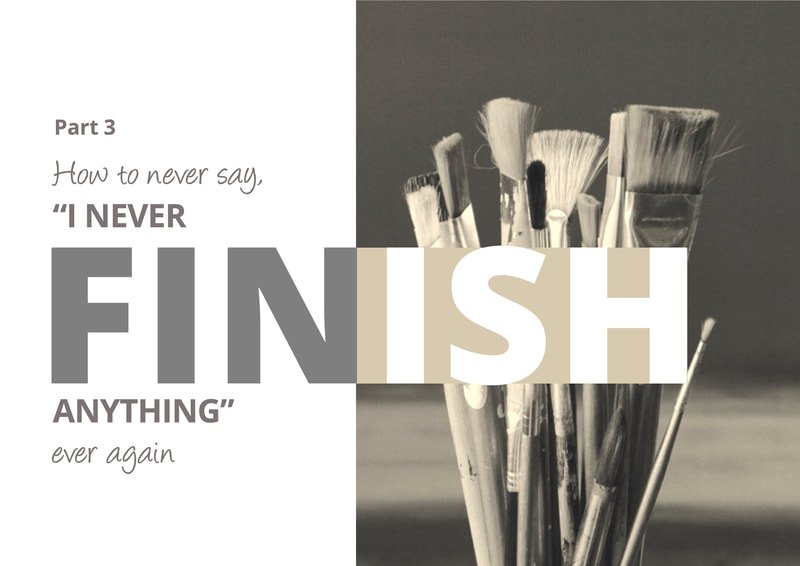PART 3
How to Never Say, “I Never Finish Anything" Ever Again
In the previous two sections, we looked at the reasons why it’s so important to finish our creative projects. And we dug into the strategies for making finishing much more likely.
Yet even with all this foundational work, we still need to keep going until the end. And when it comes time to call done, we need to bite the proverbial bullet and ship our work.
During these stages there’s still a host of ways we can fall off the horse and struggle to get back on again.
In this final piece of the ‘Finish’ trilogy, we’ll look at the best approach for keeping going to the end. And finally getting our work out into the world.
Why is finishing so hard?
The irony isn’t lost on me that the third part of this article has been the hardest to finish.
Starting a project can be an opportunity for procrastination. The middle is a time when we can feel lost or indecisive. But the end is the hardest.
The end is the time when we must face up to what we’ve made. We must trade vision for reality. Swap our fantasies of greatness for an earthly manuscript, a tangible work of art.
What’s more, the moment when we put our work out into the world is imminent. We’re about to discover what other people think about it. And we have to be ok with that.
Each piece of creative work we make is our child. First we dream with it. Then we nurture it. Now we must send it, defenceless, off into the world for its first day at the school of hard knocks. No wonder we’d rather keep it warm and safe and unfinished!
That’s why during this final stage, in the blink of an eye, we can switch from loving our work to feeling that it’s completely worthless.
This is fear speaking.
We believe we’re seeing the work with the eye of our audience. And that they hate it.
But the truth is we can never know what the audience’s reaction will be. So we’re torturing ourselves for nothing.
Despite all the difficulties, I have learned to love finishing. When I strap myself into the driving seat for that final stretch of road, there is an easing of tension. Whatever the outcome, it will soon be over and I can give my attention to something new. And who doesn’t love starting something new?
I’m going to share how I face down that fear of finishing. And win.
Scroll down to keep reading or
Get the Definitive Guide to Finishing
All three long-form articles combined in one 115 page book.
Beautifully laid out in an easy-to-read format.
Read offline on any device.
How to keep going towards the finish
First off, pat yourself on the back.
You’ve done everything you can to prepare for your project.
And you’ve made a clear plan to get it underway.
Although finishing feels hard, in fact you’ve done all the ground work. Now all you need are some savvy strategies for keeping yourself in motion until the end.
Baby steps
The first, and most important strategy is a classic one. Baby steps.
One of my clients says that the biggest gift I ever gave her was to teach her how to take baby steps. Whenever she gets overwhelmed now, she knows I’ll ask,
“What’s the first tiny step towards this?”
It doesn’t matter how big your project is. The truth remains that it’s the small, incremental acts that will get you there.
Identify the tiny next step
Whenever you feel tiredness or overwhelm taking over, pause. Then refer to the project checklist you created. Ask yourself what the very next step is.
Do that one thing.
Breathe.
Then rinse and repeat.
Check in with your objectives regularly
As we’ve seen, setting clear objectives for your project makes it a whole lot more likely you’ll get it finished. But this works only if you regularly make sure you’re still heading towards those objectives!
Your objectives are not something to write down and forget. Instead you should check in with your objectives at least monthly, if not weekly or daily!
Of course, it is possible that you’ll adjust the direction of your project along the way. So it’s imperative to make sure that these shifts are in line with your original objectives. And if they’re not, you need to be clear why you’re changing your objectives. And what your new objectives will be.
(Grab this FREE Trello board to keep a beady eye on your objectives!)
Don’t let your inner critic derail your goal
Designing a new landing page for your website? Suddenly you decide you must redesign the whole website.
Writing a short eBook to give away free as a lead-magnet? On the spur of the moment, you switch to writing a full length book and publishing it on Amazon.
How do we morph from such modest tasks to outsized ambitions while barely missing a beat?
I’m sure you can guess the answer. It’s the work of our favourite shape-shifter, the Inner Critic.
The Inner Critic knows that the quickest route defeat is overwhelm. So as you get close to finishing, he moves the finish line further away. A lot further away!
The good news is that it’s easy to recognise this tactic once you’re aware of it.
Recording your objectives - and regularly checking back on them - is the most effective way of doing this.
It’s pretty hard to argue with something that’s written in black and white!
But beware, your Inner Critic is wily! S/he might persuade you to change your original objectives document. If you think that could happen, give a copy to a trusted other - partner, friend or your coach - and ask them to hold you to it!
Have Fun!
In Part 2 I talked about intrinsic motivation. And how we vastly underrate how much enjoying our work contributes to finishing.
With all due respect to Mr Steven Pressfield, I’m not a subscriber to the art-as-war school of creating.
Life is short and full of difficult challenges that we don’t get to choose. We owe it to ourselves to make the parts we can control as enjoyable as possible. Why drag yourself like a bonded serf to your creative work if you can bounce there Tigger-like instead?
So, whenever you find yourself facing a bout of resistance in your project, ask yourself,
“How could I make this more fun?”
Try it. The result might surprise you.
Share your work. But be careful with whom. And when.
Great, now you're having fun with your work! But it’s easy to forget that not everyone shares your enthusiasm or vision.
Sometimes you feel so Tigger-‘ish that you bounce right into showing the wrong people your work. Or the right people at the wrong time.
I bet you've had this experience at least once.
You excitedly share your latest WIP with a family member or close friend. Instead of an enthusiastic response they give you that look that says,
“Isn’t it time you got a 'real' job?”
This is made worse by the expectation that we share everything on social media. We feel we should share our works in progress even when they’re not ready to be shared.
Remember what we said about creating with ‘one eye on the audience’? Sharing your work when it’s still in its infancy can be a version of this. You’re desperate for approval of your chosen direction. So, instead of tuning into to your inner compass, you go looking for external validation.
Of course, getting constructive feedback is useful. And asking for help from knowledgeable peers or getting your work edited or reviewed can both be part of the process of finishing. But in the early stages of your project, make sure you choose your critics wisely. And be specific about the kind of input you want. Or, rather than boosting you on your journey, the feedback you receive will stop you in your tracks. Or derail you completely.

Take a break
When you finally get yourself into the zone, you may start loving your project so much that you don’t want to put it down. But for the sake of your health and your relationships, it’s important to schedule some quality down time. Or you’ll soon hit burn-out, and your productivity will plummet.
Remember, you can’t ever guarantee the success of your project beyond your own personal satisfaction in completing it.
What if it takes you two years to complete your project? During which time you neglect to exercise, eat well or spend time with your loved ones. And then your project bombs! You’ll feel like a double loser, right?
So don’t lose sight of the other priorities in your life. Your dog needs his daily walks even though you’re writing the 21st century equivalent of War and Peace. You still need to phone your Mum. Or go on a date with your significant other.
And don’t forget, the time you spend exercising and relaxing helps your brain recharge. And improves your productivity. So no excuses!
Reward yourself
Taking time out is not all about pleasing others.
It’s important to reward yourself for each milestone your reach on your project journey.
A little self-love goes a long way to help you navigate the next set of challenges which await you.
Your creative self is like a child. Offer her playful incentives and she will behave well. Punish her and she will turn sulky and hide in a corner.
So every time you cross a big ‘to do’ off that list of project activities, down tools and do something nice. Just for you.
“Never quit something with great long-term potential just because you can’t deal with the stress of the moment.”
SETH GODIN
What to do when you feel like quitting
As I’ve said, finishing is hard.
It hurts.
It feels like it’s taking way longer than it should.
There are going to be days when you’re going to want to quit. This is normal and natural because you’re human.
But you’re not going to give in this time. Oh no you’re not!
Instead you’re going to learn to recognise the signs. Then use robust strategies to overcome that feeling of wanting to give up.
Recognise that "I want to quit" feeling
Have you ever gone on a hike, only to get lost or take an interesting detour? Then you realise that it’s going to take a lot longer to get home than you thought.
You’re plodding along, feeling ever-more tired. And there comes that point when you want to quit.
You sit down at the side of the trail and imagine not going any further.
But, of course, you can’t.
So you drink some water, maybe a nibble on a snack. Then you hoist yourself onto your feet.
After a short time back on the trail you get the proverbial second wind! Your legs are no longer burning. You’re no longer gasping for breath. In fact you start to feel rather strong and powerful as you stride along.
Finishing a project is the same. You’ll inevitably reach that point where the finish line feels so far away that you want to give up.
Take note of this moment!
This moment is crucial. This is when you decide whether to flake out at the side of the road, or have a short rest and a snack, and get going again.
I’ve trained myself to become aware of the moment when I want to quit. I can actually feel it in my body. It’s almost like that ache you get in your bones when you’re coming down with a fever.
This is resistance with a capital R!
And it’s powerful precisely because we are tired and depleted. Because we've already come so far.
So it’s important to take a moment to metaphorically sit down at the side of the trail. To take a small rest. Nibble on a healthy, energy-giving snack.
Know that you can and will get your second wind. That you will get back onto the trail.
Here’s how to do it.
Pause and review
When you feel like quitting, first go back to the “How to keep going” section and work through the steps there.
Make sure you’re still in line with your objectives and haven’t moved the goal-posts.
Do you need more than a pause? Perhaps you’re depleted and need a serious rest.
Have you been rewarding yourself or treating yourself like an indentured servant?
Ask for help
If you still feel stuck then this is a great moment to ask for help. That's what friends and colleagues are for!
Someone who hasn't been staring at the project for weeks can give you fresh insight. They may even have ideas on how to complete the project better and faster.
Or it may be that when you verbalise your concerns to someone else, you’re suddenly able to see the answers yourself.
This happens to me so often! I make an appointment with my other half to talk about my problem with a project. Then half way through explaining the issue to him, I come up with the solution myself!
Good enough versus perfect
If you’ve paused and reviewed and even asked for help but none of these resolve the problem, you’ll need to dig deeper.
As you get close to the end, two things need to happen. You need to step back to see the project as a whole rather than in its component parts. And you need to zoom in on the details and make sure the i’s are dotted and the t’s are crossed.
Both of these are important. Both of these are the work.
But, unfortunately, both of these have the potential to send us into a spiral of panic. And lead us to a wrestling bout with one of two demons:
1. The Demon of Disconnection
When you step back and take a wider view, you may become aware that something doesn’t feel right. Perhaps you’ve been subliminally aware of this all through the project but kept pushing it down. Or maybe you’re only noticing it now.
Either way you start to feel disconnected from the work. Instead of feeling like its the most important thing in the world to you, you feel like you don’t care.
2. The Demon of Perfectionism
The end of a project is a flashpoint for perfectionism to set in. You can obsess about details to the point of absurdity.
When I first met my other half, I was working as a graphic designer. He swears he watched me move a comma backwards and forwards 20 times before deciding where it should go.
Perfectionist? Me?
So when we get stuck during the last stages of a project, we can be sure we’re dealing with one of these two demons.
But how do we know which? And what action to take?
Let’s take a look at both in more detail.
Understanding disconnection and dissonance
So, as we’ve seen, at the end of a project we might need to step back and get a wider view.
But what happens when you do this and feel “My darling, I just don’t give a damn.’
You’re not excited. You wonder why you've spent a huge amount of time working on this utterly mediocre thing.
Feeling disconnected from the work is a major reason for wanting to give up.
But this is the WRONG moment to give up!
What’s actually happening is that your wires are crossed. Feeling dissonance means there's something within the project that needs your attention. Something that’s worth spending time improving.
I’m not talking about perfectionism. Noooo! There’s no such thing as perfect. (We’ll talk about that more in the next section.)
You feel disconnected because you’ve created something that’s ‘good enough’. But deep down you know you’re capable of making it that bit better.
And that bit can make the difference between the work being good and being great.
Polish but not until perfect
That’s why the last 15% of a project can take as long as the first 85%. This is the time where you polish your project.
It’s good to allow for this in your planning. This is when you revise, revisit and even reimagine.
Now is your chance to go the extra mile to make something that is outstanding.
Resist the urge to call done. Before it is really done
So when your work looks done but you sense that there’s a way to make it even better, make time to stop. Engage with those ideas that are hovering at the periphery of your subconscious.
Sometimes you only need to fix a small thing to fall in love with your project all over again.
Sometimes it’s more major. Then you have to weigh up whether it’s worth the time or it’s something you can live with.
Maybe it’s a fix you can make in a later version or edition of the work. (See Minimum Viable Product later.)
Maybe it’s a lesson learned for next time.
Or maybe it’s one of those moments when you have to grit your teeth, roll up your sleeves and get that dirty work done. Because you know, if you do, you and your project will be in a lot better place in the end.
How to get in touch with messages from your subconscious
Finding it difficult to figure out exactly what it is that’s bothering you about your project? Try stream-of-consciousness drawing or writing, or brainstorming to loosen stuck gears.
Start by getting every possible idea and solution down on paper without censoring.
Then narrow the playing field. Which actions will have the biggest effect - relative to the time, energy and resources involved?
Remember you’re aiming to finish this project, not start a new one!
“…developing tolerance for imperfection is the key factor in turning chronic starters into consistent finishers.”
JON ACUFF
Perfectionism and the fear of finishing
So what if it’s not a wider perspective we need? What if, instead, the problem is in the details?
Unfortunately, details are fertile ground for the Demon of Perfectionism. He walks around with his magnifying glass, inspecting the tiniest components. And finding them wanting!
This focus on (usually unimportant) details can get in the way not only of finishing, but of the final polishing we talked about.
You can’t zoom in 1000% and stand back at the same time. When you’re focussing on minute details, you can't get a sense of how the whole project is coming together.
The devil is in the details
But that’s not to say that details aren’t important. Nobody wants to read a book full of spelling mistakes.
Dotting your i’s and crossing your t’s will always have an important place in the process.
But almost anyone is a better candidate for this work than you!
So rather than fixating on this part of the process yourself, get other people to do this work.
Fresh eyes will see the mistakes and inconsistencies that you and I miss when we’ve been staring goggle-eyed at the same piece of work for months on end.
Plus getting people to look at your work at this stage is a great stepping stone towards calling done. It starts the process of sending the work out into the world - but in a controlled and specific kind of way. Which makes it a lot easier on your inner critic!
Ship it! How to finally finish your project
Remember I said that putting your work out into the world is like sending your small, defenceless child off to the first day at school? Well that child carries your DNA. So essentially you’re sending a part of yourself defenceless out into the world.
Yep. That’s why it feels such a wrench.
And why - even though you’ve overcome perfectionism and/or disassociation - you might still experience resistance to actually finishing.
Here are some final strategies to get you over those last few yards to the finish line.
1. See your project as part of your body of work
One way to stop yourself overly-identifying with an individual project is to see it as part of a greater, body of work.
A body of work is something developed over time. Its value is in the sum of its component pieces rather than the worth of any individual piece.
In any body of work, there will be stronger and weaker pieces. When you accept this as normal and inevitable, it stops you being so hung up on any particular piece.
This project doesn’t define you. And it won’t be your last. Whatever the outcome of this single piece of work, you’ll learn from what you’ve done and move on.
Seeing it this way helps a ton when it comes to sending your work out into the world.
2. Create an MVP
In many areas of creative work these days, it’s easy to edit and improve the existing version of your work.
You can re-edit your book in two year's time and relaunch it.
You can revisit your song or your entire album.
And even with art, you can create variations on the same idea. Picasso painted 58 versions of Las Meninas!
In tech circles this is known as a Minimum Viable Product (MVP).
The MVP concept empowers you to get your creative work out there. Then you carry on 'tweaking' and improving once it's launched.
It allows you to show something to the world and get feedback from your target demographic.
Creating a MVP allows you to ship knowing that your work isn’t perfect. And we know that perfection doesn’t really exist, don't we? So this is a great way to fool your inner critic into letting you ship your work!
In fact it kills two birds with one stone when it comes to the Inner Critic. Because it also deals with the tendency to move the goalposts we talked about earlier. If there's a LOT more work you want to do after you've shipped your MVP, this becomes a new project.
Instead of fiddling endlessly with your current version, you can call done, perhaps work on a different project for a while, and then come back to version 2 with new energy and insight.
3. Act ‘as if’ you’ve finished
I've got a favourite trick for when I'm facing a huge amount of resistance to finishing. I start acting as if I'd already finished.
In other words, I start doing all the things I normally do after I complete a project. From cleaning up my studio space to planning down time:
Tidy up desk/studio/workspace and put away items used earlier in the project but don’t need now.
Create accountability by announcing a launch date.
Start a new project folder/Pinterest board for potential next project and add material to it.
Book a post-finishing celebration - a meal out with a loved one, a massage, a night away visiting a friend. It doesn’t have to be big, but it should be concrete and involve a commitment.
It’s amazing how taking actions associated with finishing can change your mindset. Once I start doing these things, I'm more positive and committed to finishing. And, hey presto, my energy for getting the work out of the door returns!
Try it yourself. This strategy works surprisingly well!
How do you know when you’re finished?
So this is it. You’ve worked down your final list of actions.
But, as we know, the creative process never conforms to a to do list.
So how can you be sure you’re actually done?
Here are some of the ways to tell when you’re finished:
It goes quiet in the room. I feel this as a sudden silence in my head. My inner critic has stopped nagging. My critical faculty is happy. I hear the birds twittering on the roof.
You’ve gone into overworking mode. Things are starting to get worse rather than better. You’re fiddling for the sake of it. Put the brush down!
You feel scared. OMG, you’ve made something amazing!
Or, as Jackson Pollock said when asked how he knew when a painting was complete,
“How do you know when you’ve come?” 🤣
How to deal with post-finishing anti-climax
Congratulations! You’ve shipped your project!
You’ve shared the links on social media.
You’ve celebrated finishing with your nearest and dearest.
The likes/sales/bookings are rolling in. Or maybe they’re not.
But, whether the outcome of your project is thundering applause or a deafening silence, you’re likely to feel a big sense of let down.
I call this "Post-finishing anti-climax”.
“You cannot avoid the decline that comes AFTER THE END, yet you can learn to survive such times and emerge strengthened in spirit and character.”
The Chinese divination system, the iChing, calls this moment "After the End". Sounds paradoxical, right? Because in the fairy tales, there isn’t anything after The End.
But the Chinese sages knew that life is no fairytale. And we have to deal with the natural fallout we experience when we complete a cycle.
Not only that, but the iChing places "After the End" in the penultimate position in the oracle. Immediately preceding "Before the End".
That’s because we need to prepare for the fallout that comes with finishing before it hits us. That way, we’re better able to deal with it.
Creativity coach, Mark McGuinness calls these big, time and energy-consuming projects, ‘events’. To avoid burnout, advises that we schedule post-event recuperation time. This helps us recover mental, physical and creative energy.
Here are some strategies for dealing with post-finishing depletion in all its forms.
1. Let go of what you’ve created
It’s so hard to separate the work from ourselves. So our ego tends to be very fragile after we finish a project. We internalise every comment or response as if it were about us.
This can turn toxic. To avoid this, I create two mental boxes. In one goes the making of the work. In the other, its life after it leaves me.
I can control what happens in the creation box.
I have extremely limited control over the ‘after’ box. I exercise as much of that control as I can by sharing the work. But, beyond that, I have to leave it in the lap of the gods.
2. Do some rote activities
Every business or practice has its share of rote activities. These are mindless or boring things we need to do, but which often take a back seat when we’re in the throes of creating.
The post-project period is the ideal time to get your proverbial house in order. You can use it to chunk through a bunch of these rote activities.
You’ll feel empowered by getting tasks out of the way that have been languishing. And your mental and creative energy will have time to recharge.
3. Fill the well
You’ve just completed an intense cycle of giving. You’ve dug into the depths of your creative being and given everything you’ve got to your project. This is intensely draining for your creative well. So in the post-finishing period, it’s essential to recharge.
I like to recharge by:
Reading
Pinning ideas for new work to my secret Pinterest boards
Getting out to see art or theatre
Walking in nature or doing yoga
You’ll have your own ways of refilling your creative well. Whatever they are, now’s the time to use them!
4. Review
Once the fog clears a bit and your energy begins to return, it’s a great moment to review the trajectory of your project.
Whatever the outcome of your work, you’ve doubtless learned a ton. Don’t let all the valuable insight you’ve gained dissipate!
Check out this post on how to do a creative project assessment. It will help you activate the power of your completed projects!
After the end
Finishing is hard - but you CAN do it!
In this series we’ve looked at:
The reasons why it’s so important to finish the projects we start.
How to set up conditions that are favourable for finishing.
Why finishing is hard. But how we can use insight and basic strategies to overcome the hurdles that stop us in the final furlong.
Finishing is like any habit. We build strength over time.
Once you‘ve completed a number of projects, your confidence in your ability to finish will go right up. Then you'll be much less likely to leave future projects unfinished.
I hope this series will help you in your bid to finish your creative projects. And get more of them out into the world.
The Definitive Guide to Finishing eBook
I know it’s hard to take in so many ideas when reading them online. So I’ve put together an eBook combining all three of these long form posts in a more digestible format. Read it offline at your leisure, annotate it in your PDF editor. And buy me a coffee in your support for this blog ;)




















